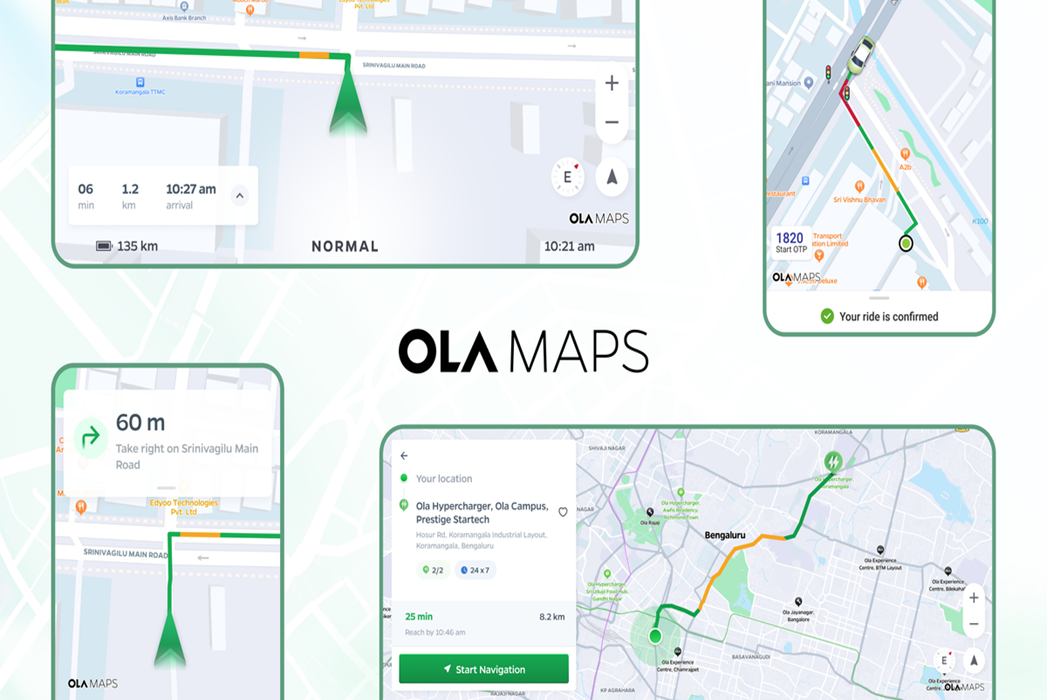Ola Maps Challenges Google Maps with India-Centric Innovations
In a bold move toward digital self-reliance, Ola, India’s leading ride-hailing company, has launched Ola Maps on July 5, its in-house mapping service, as a replacement of Google Maps in India. This transition follows Ola’s recent exit from Microsoft’s Azure platform, marking a significant step towards a fully independent tech infrastructure.
“After #ExitAzure, it’s time for developers to #ExitGoogleMaps! 1 YEAR FREE access to all developers to Ola Maps on @Krutrim, more than ₹100Cr in free credits! Ola Maps.”
This tweet from Bhavish Aggarwal, CEO of Ola, is a clarion call for developers to switch to Ola Maps, offering substantial incentives and support. The recent migration from Microsoft Azure to Krutrim Cloud, Ola’s in-house AI platform, also underscores the company’s commitment to building a self-reliant and innovative tech ecosystem in India.
India’s Mapping Battleground
The Indian app market is now a battleground, with Ola Maps positioned as a strong alternative to Google Maps. Bhavish Aggarwal made a bold statement on social media, urging developers to switch from Google Maps to Ola Maps, which is crafted specifically for India’s unique and often challenging landscape.
As per Bhavish, Ola Maps isn’t just another mapping service; it’s a tailor-made solution for India. Branded as “Crafted for India” and “Priced for India,” it offers a suite of APIs and SDKs designed for Indian entrepreneurs, students, and developers. This project underscores Ola’s commitment to the domestic market, positioning it as a serious contender in a space traditionally dominated by global giants.
The Vision Behind Ola Maps

Ola Maps emerged from the need to address the limitations of existing mapping providers, which often miss the intricate details and nuances of Indian geography and urban infrastructure.
Bhavish Aggarwal emphasized the necessity for a mapping solution that accurately maps street names, navigates urban changes, manages complex traffic patterns, and deals with non-standard roads—challenges that Western mapping providers often fail to address.
Ola’s vision is forward-thinking: it’s not just about current needs but anticipating future mobility innovations like autonomous vehicles, flying taxis, and drones. This required a dynamic, intelligent mapping platform, and thus, Ola Maps was born, leveraging AI-powered algorithms, real-time data from millions of vehicles, and significant contributions to open-source mapping projects like OpenStreetMap.
Harnessing Local Insights and Data

A key differentiator for Ola Maps is its deep integration with the Indian ecosystem. By harnessing data from diverse sources, including real-time inputs from Ola’s extensive fleet equipped with advanced sensors and 360-degree cameras, Ola Maps provides highly accurate and up-to-date information, capturing the ever-changing dynamics of Indian roads.
Additionally, Ola Maps incorporates data from open-source government resources, local businesses, and community contributions, ensuring the service is culturally resonant and relevant.
Features like multi-language support, local business listings, and culturally significant landmarks enhance the user experience, making Ola Maps truly India-centric.
Technical Innovations and Features
Ola Maps is built on a sophisticated data platform (Ola Maps Places Platform) capable of processing over 5 million messages per second from various sensors and telemetry sources. This real-time processing power ensures the maps are always accurate. Some key features include:
- AI-Powered Algorithms: Advanced AI analyzes vast data, offering accurate predictions and real-time updates on traffic, routes, and travel times.
- Real-Time Data Integration: Insights from millions of vehicles provide up-to-date information on traffic patterns and road conditions.
- 360-Degree Mapping: Fleet-equipped 360-degree cameras capture detailed street-level imagery, enhancing accuracy and user experience.
- Localized Features: Tailored for India with regional landmarks, multi-language support, and culturally significant points of interest.
- Open-Source Contributions: Significant contributions to OpenStreetMap enrich global mapping data specific to India.
Strategic Pricing Model
Understanding the cost sensitivities of Indian developers and startups, Ola has introduced a competitive pricing model for Ola Maps. Initially, the service is offered free for all developers for the first year, with additional incentives for those committing to longer-term usage.
For example, developers signing up for more than three years can avail themselves of two years of free usage, while startups and small and medium businesses (SMBs) building apps on the Open Network for Digital Commerce (ONDC) can enjoy three years of free subscription.
This aggressive pricing strategy aims to democratize access to high-quality mapping services, enabling more Indian developers to build and innovate without the financial burden typically associated with such resources.
Google Maps’ Response
Ola’s bold move did not go unnoticed. In a swift response, Google announced a 70% reduction in Google Maps API prices for Indian developers, effective from August 1, 2024. Additionally, Google introduced a 90% discount for developers working with ONDC, emphasizing its commitment to supporting the Indian tech ecosystem.
However, Bhavish Aggarwal was quick to critique Google’s price cuts, labeling them as “too little too late.” He pointed out that tech giants had long viewed India primarily as a market to exploit, imposing high costs on developers while often neglecting India’s digital sovereignty.
By offering localized pricing and payment options in Indian rupees, Ola aims to address these disparities and foster a more inclusive and supportive environment for Indian developers.
Comparison Between Ola Maps and Google Maps
| Aspect | Google Maps
|
Ola Maps
|
| India-Centric Features
|
Comprehensive but may lack local nuances.
|
Tailored for India with localized data and features.
|
| Geographic Focus
|
Global coverage.
|
Primarily focused on India.
|
| User Base | Larger, global user base.
|
Smaller, India-focused user base.
|
| Updates and Accuracy
|
Frequently updated with global accuracy.
|
Frequent updates with potential advantages in Indian localities. |
| Company Origin | Developed by Google, a multinational tech company.
|
Developed by Ola, an Indian ride-hailing company.
|
| Integration with Ride-Hailing
|
Offers integration with multiple ride-hailing providers.
|
Tightly integrated with Ola’s ride-hailing services |
| Different Data Sources
|
Global data sources, including satellite imagery and user contributions. | Localized data sources, real-time inputs from Ola’s fleet, open-source contributions. |
| Pricing
|
Recently reduced API prices by 70% for Indian developers; 90% discount for ONDC developers.
|
Initially free for one year, with additional free usage incentives for long-term commitments.
|
| Technical Features | Advanced AI, global data integration, extensive feature set. | AI-powered algorithms, real-time data from millions of vehicles, 360-degree mapping, localized features.
|
What We Think
Ola Maps represents a significant milestone in India’s journey towards digital self-reliance. By addressing the unique challenges of the Indian market and offering a competitive pricing model, Ola positions itself as a potential competitor to global giants like Google. However, independent user reviews and comparisons will be crucial in evaluating whether Ola Maps can truly deliver on its claims and become a superior alternative.
Stay tuned for more updates and exciting features from Ola Maps. Visit Ola Maps for more information and to explore the possibilities, but also investigate independent assessments to make an informed decision.





